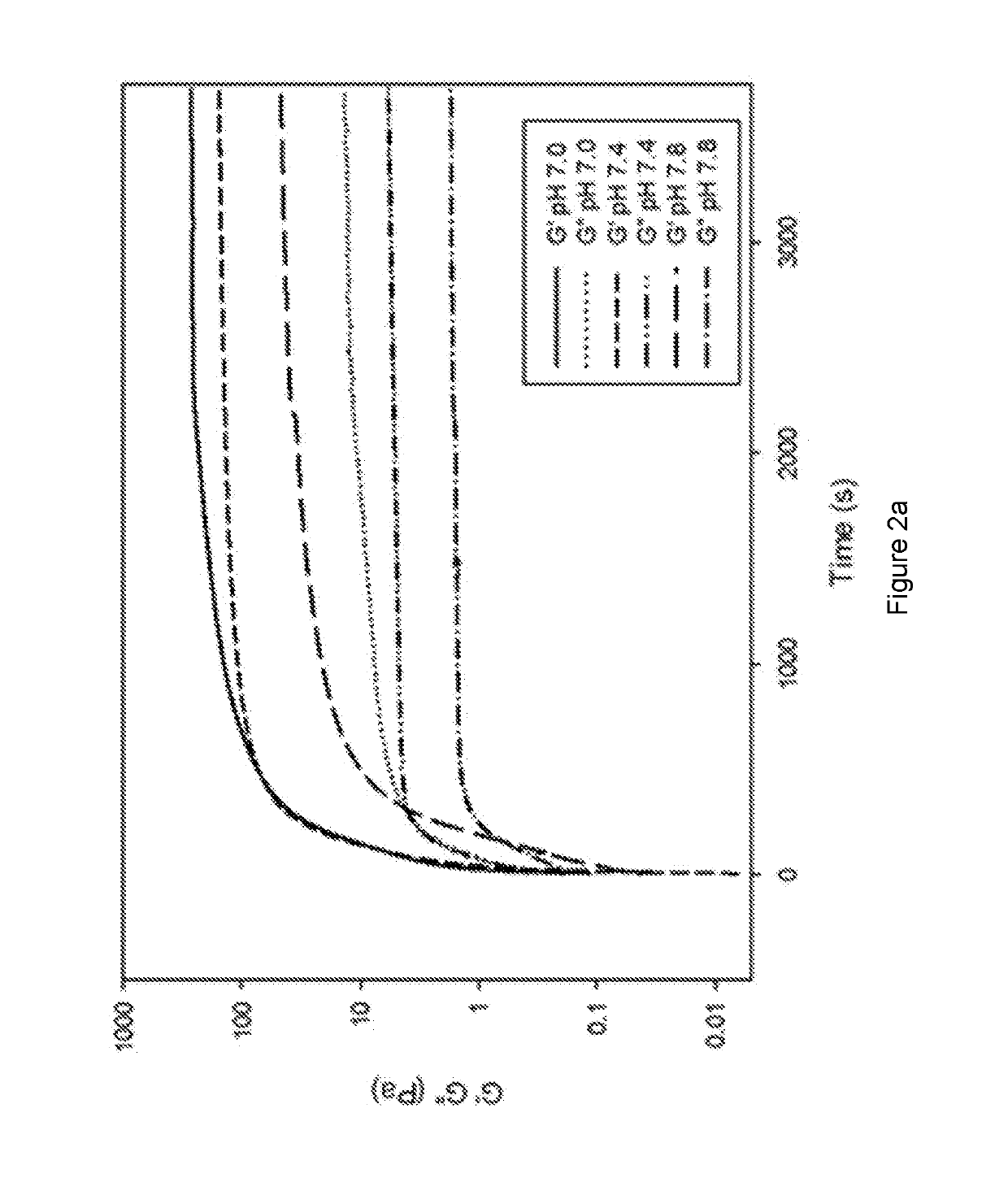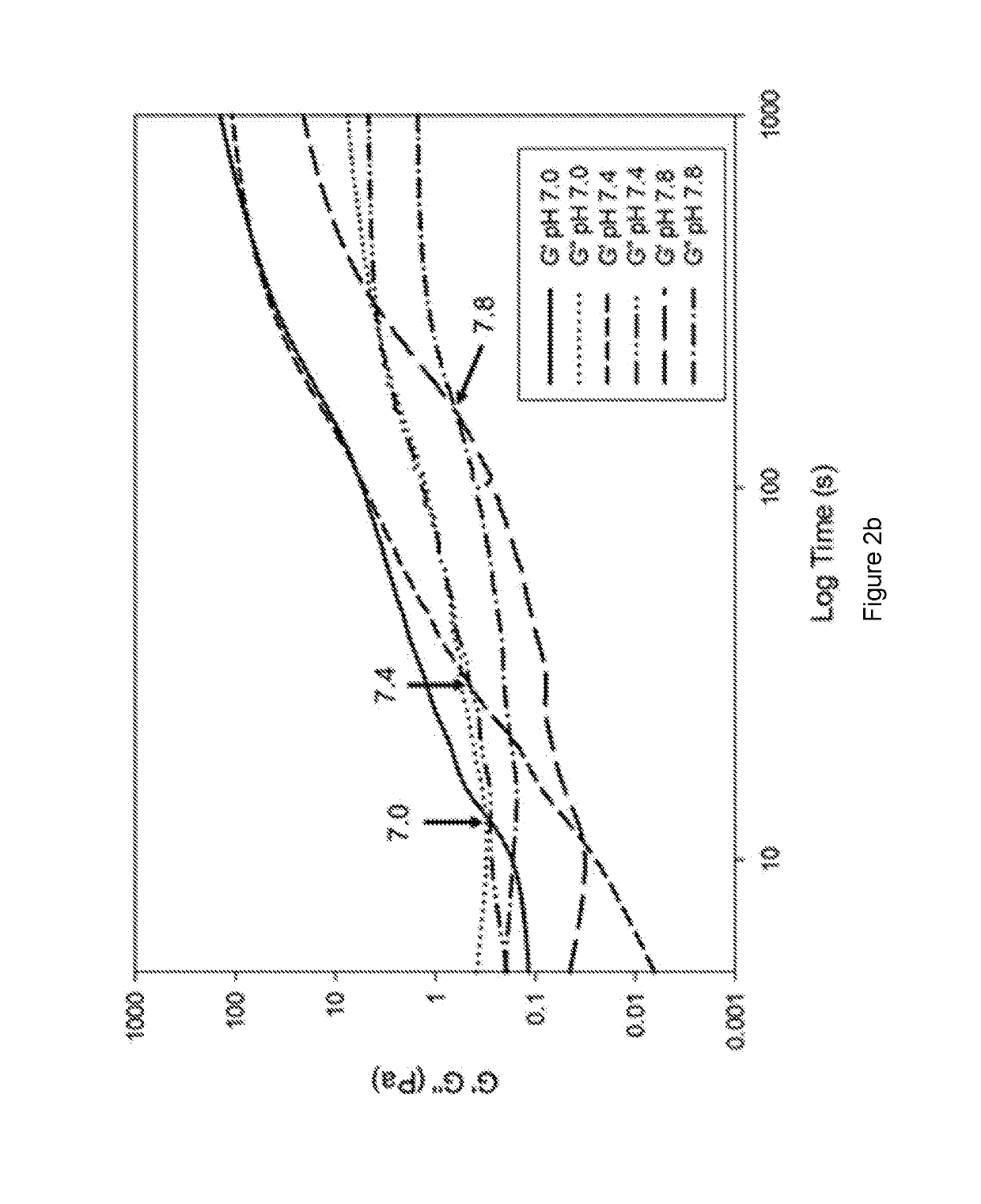Methods of forming ionically cross-linked gels
a technology of cross-linked gels and gels, which is applied in the field of gel formation, can solve the problems of reducing the material performance of a given application, affecting the final product, and affecting the performance of materials,
- Summary
- Abstract
- Description
- Claims
- Application Information
AI Technical Summary
Benefits of technology
Problems solved by technology
Method used
Image
Examples
example 1
[0082]A CaEDTA / ZnEDDA, 1% Alginate hydrogel was prepared as follows:
Preparation of Alginate-CaEDTA Solution
[0083]i) Alginate was dissolved to a concentration of 3 wt / vol % in water to produce an alginate stock;[0084]ii) An aqueous CaCl2 solution was prepared having a concentration of 1 M;[0085]iii) An aqueous EDTA solution was prepared using NaOH (0.5 M, pH 8-9);[0086]iv) An aqueous buffer was prepared using MOPS (pH 7.0) at a concentration of 1 M;[0087]v) Next, the Ca2+, EDTA and buffer solutions were mixed at a molar ratio of 1:1:1;[0088]vi) pH was adjusted to pH 7.0;[0089]vii) The alginate stock was mixed with CaEDTA-buffer solution in proportions to give 1% alginate concentration and 60 mM Ca2+ / EDTA / MOPS.
Preparation of Alginate-ZnEDDA Solution
[0090]i) Alginate was dissolved to a concentration of 3 wt / vol % in water to produce an alginate stock;[0091]ii) An aqueous solution of Zn(CH3CO2)2 was prepared having a concentration of 1 M;[0092]iii) An aqueous solution of EDDA solution w...
example 2
[0098]The cells may be compartmentalised as follows. Preferably, a low viscosity hydrofluoroether (such as 3M™ Novec™ 7500 engineered fluid (HFE7500) that offers high gas transport and avoids swelling of PDMS devices, was used as the continuous phase. A fluorosurfactant (in this case, 2% (v / v) Krytox®-PEG600 based fluorosurfactant) was added to the continuous phase to facilitate droplet breakup, stabilize emulsions and to avoid coalescence. Two dispersed phases were used: (1) 0.6% (wt) alginate containing 84 mM Ca2+ / 84 mM EDTA / 40 mM MOPS at pH 6.7 and (2) 0.6% (wt) alginate containing 84 mM Zn2+ / 100 mM EDDA / 40 mM MOPS at pH 6.7. The two aqueous phases meet in a co-flow region in the microfluidic channels prior to droplet break-up.
[0099]The flow rates were set to 200 μL / hr for the continuous phase and 50 μL / hr for both aqueous phases by controlled injection using plastic syringes mounted on syringe pumps from Harvard Apparatus (PHD ULTRA). The syringes used for the dispersed phases c...
example 3
[0100]A CaEDTA / ZnEDDA, 0.4% Alginate, 1% Collagen Type I hydrogel was prepared as follows:
Preparation of Alginate-CaEDTA-Collagen Solution
[0101]i) Alginate was dissolved to a concentration of 3 wt / vol % in water to produce an alginate stock;[0102]ii) An aqueous CaCl2 solution was prepared having a concentration of 1 M;[0103]iii) An aqueous EDTA solution was prepared using NaOH (0.5 M, pH 8-9);[0104]iv) An aqueous buffer was prepared using MOPS (pH 7.0) at a concentration of 1 M;[0105]v) Next, the Ca2+, EDTA and buffer solutions were mixed at a molar ratio of 1:1:1;[0106]vi) pH was adjusted to pH 7.4;[0107]vii) The alginate stock was mixed with CaEDTA-buffer solution in proportions to give 0.6% alginate concentration and 36 mM Ca2+ / EDTA / MOPS.[0108]viii) The Alginate-CaEDTA solution was chilled to 4° C.[0109]ix) Next cold (4° C.) 3 wt / vol % Collagen Type I from Rat Tail dissolved in 20 mM acetic acid was added to the cold alginate-CaEDTA solution at a volume ratio of 1:2
Preparation of...
PUM
| Property | Measurement | Unit |
|---|---|---|
| temperature | aaaaa | aaaaa |
| angular frequency | aaaaa | aaaaa |
| lag time | aaaaa | aaaaa |
Abstract
Description
Claims
Application Information
 Login to View More
Login to View More - R&D
- Intellectual Property
- Life Sciences
- Materials
- Tech Scout
- Unparalleled Data Quality
- Higher Quality Content
- 60% Fewer Hallucinations
Browse by: Latest US Patents, China's latest patents, Technical Efficacy Thesaurus, Application Domain, Technology Topic, Popular Technical Reports.
© 2025 PatSnap. All rights reserved.Legal|Privacy policy|Modern Slavery Act Transparency Statement|Sitemap|About US| Contact US: help@patsnap.com



